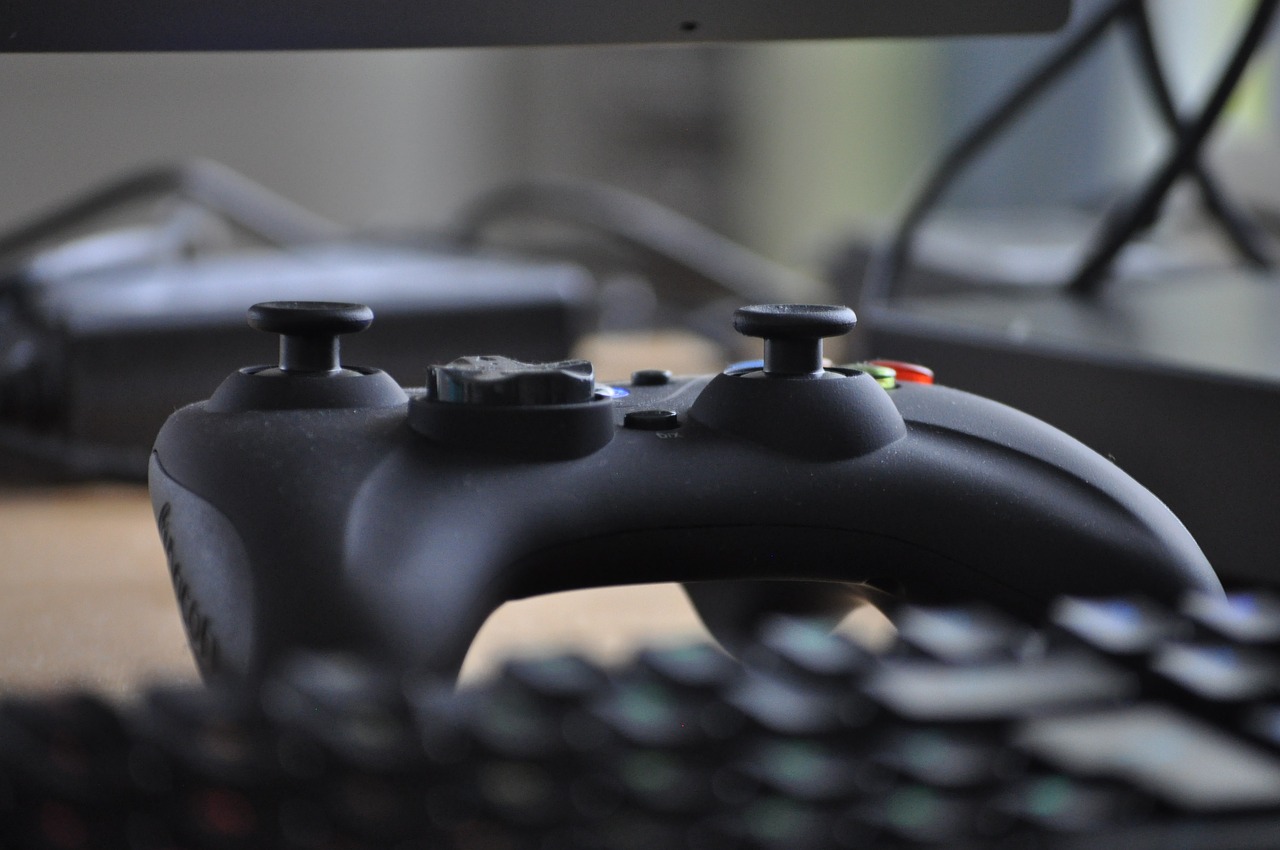
Gaming consoles are, for many, the core way to experience video games. They attract games with the biggest special effects, most epic stories, and most cultural attention.
But gaming consoles weren't always the heavy-hitting institutions they are now. The past fifty years of gaming are full of conflict and drama.
From a devastating market crash early in the history of console gaming to a three-way tug-of-war that's still in limbo, the story of gaming consoles is full of twists.
And while the current setup of flagship consoles seems like it's never going to change, a look at their history shows you never know when it's going to be Game Over.
Let's dig in:
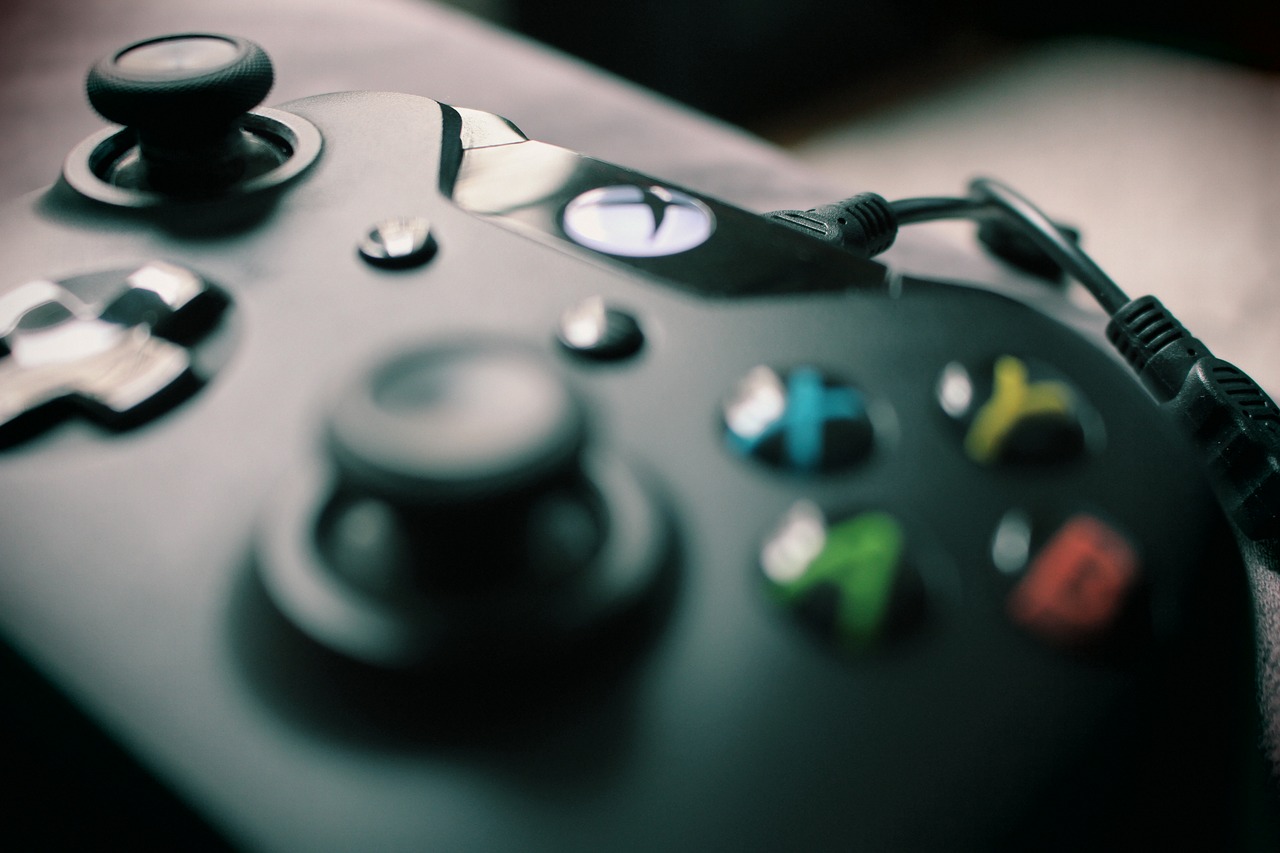
Image via Pixabay.
Eight Generations Of Console Gaming
If you're familiar with gaming as it exists now, you may be surprised to know that industry mainstays Xbox and PlayStation are actually a bit late to the game.
No, really.
Take a look:
These two contenders have dominated the past twenty years of console gaming.

Playing PlayStaion 4 Console Home photo created by jeshoots - www.freepik.com
But of the eight generations of gaming consoles spanning from around 1966, PlayStation has only been around since the fifth, in the 1990s.
And Xbox came onto the scene in the sixth, which started around 2001.
For those of you who have been playing for a long time, this won't be a surprise.
But younger gamers may not realize that beyond Sony, Microsoft, and their older competitor Nintendo, there is a much larger history of gaming consoles.
In fact, the history of gaming extends nearly as far back as the history of computers. The first gaming consoles came onto the scene as early as the 1960s.
Generation Name | Duration | Major Consoles | Tech Advances |
|---|---|---|---|
Generation 1 | 1972-1976 | Magnavox Odyssey | First home console |
Generation 2 | 1976-1982 | Atari 2600, Colecovision, Intellivision | Multiple colors, high scores, multiple screens |
Generation 3 | 1982-1987 | NES, Sega Master System | 8-bit processors, D-pads, open world games |
Generation 4 | 1987-1994 | Sega Genesis, SNES, Neo Geo, TurboGrafx-16 | 16-bit processors, multiple buttons on controllers |
Generation 5 | 1994-2001 | Sega Saturn, Nintendo 64, Sony PlayStation | 3D graphics, end of cartridge games, multimedia |
Generation 6 | 2001-2005 | Microsoft Xbox, Sony PlayStation 2, Nintendo GameCube | Online gaming capabilities, onboard memory |
Generation 7 | 2005-2013 | Microsoft Xbox 360, Sony PlayStation 3, Nintendo Wii | Blu-Ray game discs, digital game storage, motion controls |
Generation 8 | 2013-Present | Microsoft Xbox One, Sony PlayStation 4, Nintendo Wii U | Virtual reality |
Generation One: The Origins Of Gaming Consoles
The first generation of gaming consoles capitalized on the advent of televisions in American homes in the 1960s. Now that every home had a way to play, engineers started building ways to bring games to them.
This generation saw only one major console release during its span: the Magnavox Odyssey.
Every video game console since has taken from the first generation. Its simple, black and white squares and lines don't impart much meaning.
But graphics are hardly the whole story:
Images from this era of gaming consoles are as recognizable as the most iconic video game characters.
Ralph Baer and the Brown Box
Starting in 1966, engineer Ralph Baer began working on a gaming system for home use. This simple machine, which he built with the help of two other engineers, became known as the "Brown Box."
Here's the lowdown:
The Brown Box, which was multiplayer and multiprogram, was the first of its kind. Ultimately, it was only a prototype.
Until the introduction of online multiplayer, the Brown Box's system was essentially the standard for multiplayer gaming.
It introduced a game system with multiple controllers that friends and family members could play together on the same screen.
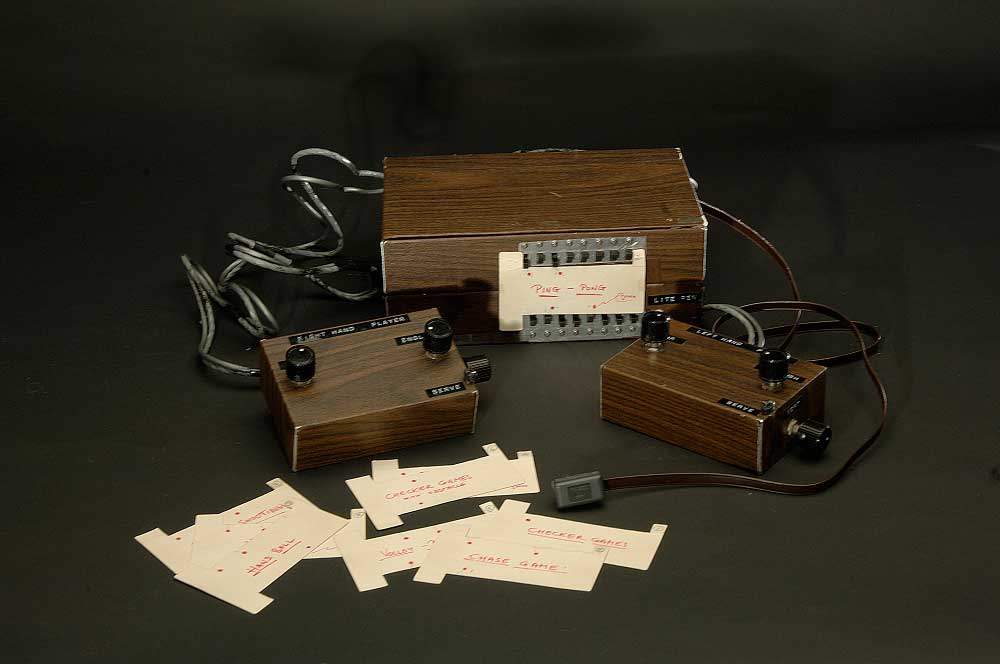
Brown Box made by Ralph Baer. Image via Smithsonian Institute
The Magnavox Odyssey
The first of the true gaming consoles was the Magnavox Odyssey. It was, in essence, the Brown Box as packaged for commercial sale.
Released in 1972, the Odyssey could only show a vertical line and a few moving blocks.
But that's not all:
To enhance the games, translucent overlays were included. These clung to the television and gave colorful context to the otherwise monochromatic games.
Sadly, the Odyssey was not a great commercial success.
But it did pave the way for the next 50 years of video game consoles.
Iconic Game of Generation One: Pong (1972).
Pong was originally released as a cabinet-based game until 1974 when Atari made it into a home console version. It was much more commercially successful than the Magnavox Odyssey.
Generation Two: The Flood Before The Fall
During the second generation of game consoles, more companies began to join in on the trend. Retro gaming mainstay Atari entered the scene with their Atari 2600 system.
But Atari wasn't alone:
Several other household names of gaming made their debut in this era, which ran from 1976 to 1982. Coleco introduced its Telstar system.
One entrant in this generation may surprise you -- Japanese playing card company Nintendo released the Color TV Game 6.
Games in this era advanced quickly from the basic blocks of the Magnavox Odyssey. They had multiple colors, distinct figures, and more detailed backgrounds.
Due to technological restrictions, most of the iconic games of this era were ports from arcade games. Games such as Pac-Man, Space Invaders, and Galaga, were ported onto generation two consoles.

Space Invaders video game. Image via Pixabay.
The Atari 2600
Atari rode the success of Pong into a game console of their own.
Have a look:
The Atari 2600 was released in 1977, sparking the second generation of gaming consoles. Many of its design choices became industry standards in following generations.
The Atari 2600's familiar wood paneling let it blend in with other pieces of furniture in the Seventies.
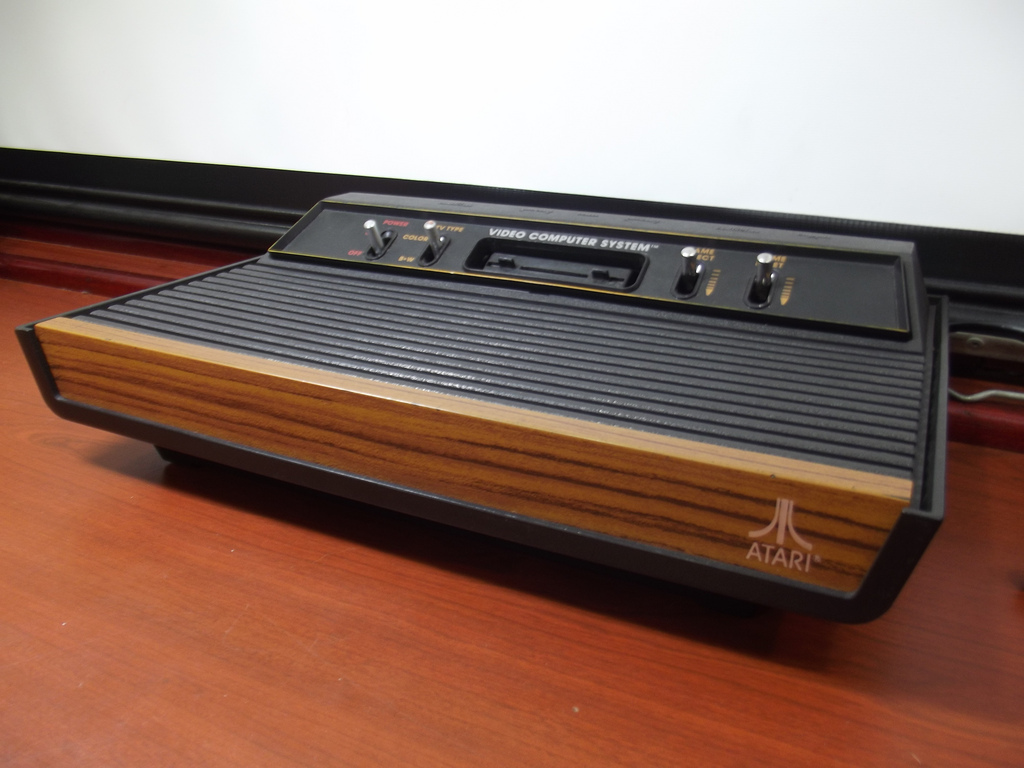
Brian Vasconcellos from São Paulo, Brasil [CC BY 2.0], via Wikimedia Commons
Players used cartridges to switch the game -- an innovation that stayed with game consoles until nearly 2000.
Controllers had one button and a joystick, and slotted together into one port on the game console.
Many Atari games were landmarks for their time, and are marked as predecessors for entire genres of games today.
Space Invaders was the first game to include a high score feature when it was released as an arcade game. When it was ported to the Atari 2600, it made the console a hit.
Iconic Game of Generation Two: Adventure (1979).
Adventure, a fantasy role-playing game, was the first ever console video game to have multiple screens. It also had the first easter egg: a hidden room with the programmer's signature.
Disruption: The Console Crash Of 1983
1983 marked a massive break in the history of video gaming consoles. An overwhelming number of video game consoles flooded the market. They didn't just make choosing difficult for gamers, though.
A lot of them were just bad. And they sold bad games to play on them.
One infamous game takes a brunt of the blame for the crash of 1983 and is part of the myth-making of video game history.
The E.T. Atari game, a notoriously bad companion to the movie, has largely been blamed for the fall of Atari and the crash overall. Thousands of copies of the game were buried in Alamogordo, New Mexico, in 1983. They were uncovered in a massive dig in 2014.
Where gaming consoles crashed, however, gaming computers were untouched. And the mistakes of manufacturers like Atari and Coleco became lessons for the next generation.
The failures of the first game makers paved the way for none other than Nintendo.
Generation Three: Nintendo To The Rescue
Unlike the past two generations, generation three didn't get its start in the United States.
Nintendo's Famicom brought this generation into being in Japan, even as the United States was in the midst of the console crash.
Here's what they had to offer:
Games of this era were famous for their 8-bit graphics, which give this era its nickname as the 8-bit era.
Controllers with directional pads (D-pads) first came into being in this generation.
Some game franchises which started in the third generation are still beloved to this day.
Plus, many genres that were impossible before now saw their start. Real-time strategy, first-person gaming, and open worlds took their first steps in the years between 1983 and 1987.
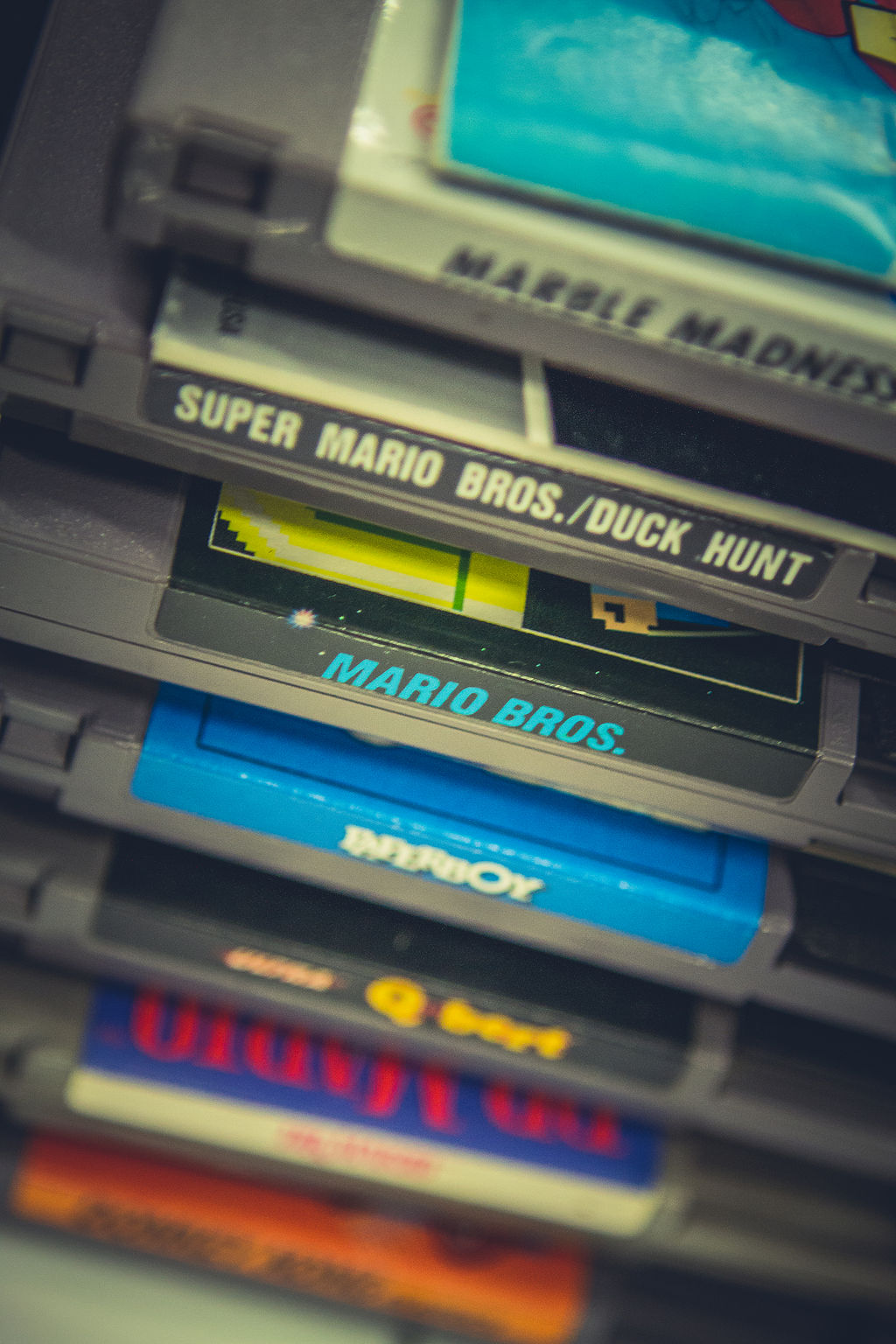
Image via Tony Webster from Portland, Oregon, United States [CC BY 2.0], via Wikimedia Commons
Famicom/NES
The Famicom was released in 1983 in Japan, the same year that the crash hit the United States. A bright red and cream-colored console, the Family Computer was a hit in Japan.
Here's what happened next:
Nintendo's 8-bit console brought arcade-quality games to the home. It was more powerful and had more memory than any other console at the time.
But the console crash kept the Famicom from coming to the United States.
Nevertheless, Nintendo uncovered how to market its gaming console in a country that did not want it, in just two years.
So how did they sell their toylike Famicom to a market that was over video game consoles?
The answer is in the design of the Nintendo Entertainment System.

Evan-Amos [Public domain], via Wikimedia Commons
The NES, a sober grey block, looked like it belonged next to a VCR and television in 1980s America.
It is also telling that the name of the console is the "Entertainment System." It is not a game console or a toy for children, but a mature system.
This marketing extended to the games as well. Box art for games such as Super Mario Bros. were honest to consumers, unlike the E.T. game.
This honest, sober marketing was comforting to American consumers. Rather than opening up customers to risk, Nintendo gave Americans games that had already sold well in Japan.
They also were strict with their approval of games, meaning companies could not make games on Nintendo that were simply advertising ploys.
The NES was not just a pivotal gaming console for its innovative gameplay. It also made Americans want to use console games again.
Iconic Game of Generation Three: Super Mario Bros (1985).
The defining game of Nintendo's entire brand, this classic drove the success of the NES and Famicom, and brought the gaming console back into style.
Generation Four: A Competitor Worthy Of Mario
Generation four advanced graphics significantly from the previous era.
Take a closer look:
This generation took processing from 8-bit to 16-bit and allowed programmers to include thousands of colors more than the previous generation.
Controllers in this era allowed for the use of more than two buttons, leading to controllers with up to eight different buttons.
Graphics also included backgrounds that appeared 3D and scrolled in parallax. This created the illusion of depth and distance.
Image via GIPHY: Mortal Kombat II, One of the Best Video Games released in this generation
Sega Genesis
Generation four also saw the emergence of Sega as a major player in the game console industry.
Earlier in the 1980s, their Master system had gone up against the NES and lost. Now, it was time for a rebranding.
So they did this:
The Sega Genesis contained a powerful Motorola processor, with the intent to accurately play arcade titles in a home format.
Although this helped them early on, they failed to compete with Nintendo based solely on the arcade tagline. Their sales were hurt especially by their failure to be placed in stores such as Wal-Mart.
One thing truly saved Sega, and even catapulted them above Nintendo for a time -- their new mascot, Sonic the Hedgehog.
Sonic, the self-confident hedgehog, made Sega the name to beat in America's late 80s.
Iconic Game of Generation Four: Sonic the Hedgehog (1991).
With Sonic the Hedgehog, Sega had a fast-paced mascot that made use of 16-bit graphics and processing. The popularity of Sonic the Hedgehog helped Sega become a competitor to Nintendo's powerhouse.
Handheld Gaming From The Gameboy To The iPhone
The first handheld gaming systems started almost as soon as major home consoles. The first was the Milton-Bradley Microvision. This device had a 16-by-16 pixel LCD screen to display games on.
Real innovation started with the Nintendo Game and Watch:
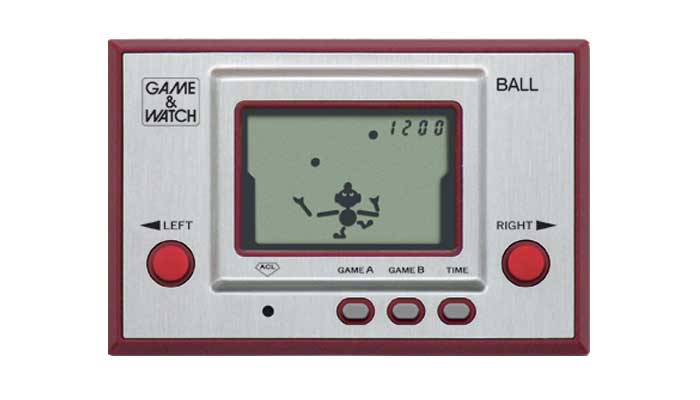
Nintendo Game & Watch: Image via Wikimedia Commons
Like its predecessors, this handheld game used an LED screen. But the Game and Watch used custom LED screens that lit up entire characters, rather than just square pixels.
Suddenly, handheld games had art that would actually engage players.
But that's only part of the story:
The next major development was the Nintendo Game Boy, in 1989.
Sega and Atari both tried to compete using full-color displays, but their lack of game options and low battery life sealed their death warrants.
Despite a few other upstarts, Nintendo cornered the market on handheld gaming until the mid-2000s.
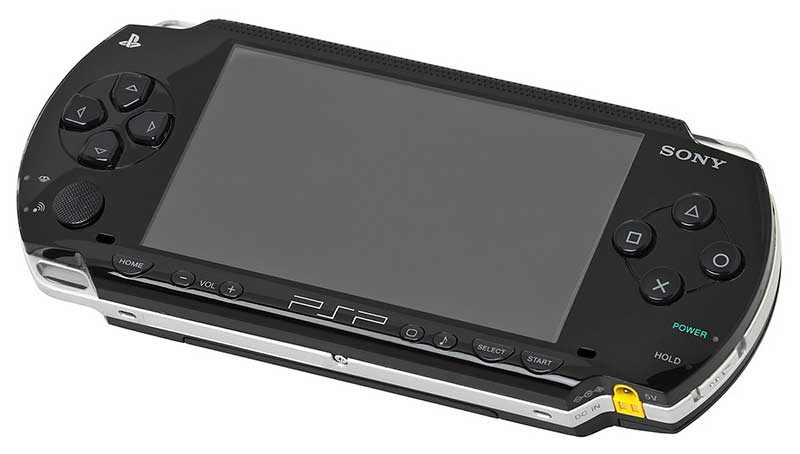
Sony PSP. Evan-Amos [Public domain], via Wikimedia Commons
In 2004, Sony made their bid on the handheld market, looking to unseat the largely-unchallenged Nintendo.
The PlayStation Portable, or PSP, featured advanced 3D graphics that Nintendo's handhelds could not offer, as well as more mature titles.
While it never outsold the Nintendo DS, which released the same year, the PSP succeeded by selling to a different audience.
Nintendo continues to dominate the handheld market, as far as game-dedicated consoles go. In fact, their new Switch console is made to switch between a home and a portable console.
The real winner in mobile gaming, however, is neither Sony nor Nintendo:

Smartphones Games: Image via freepik
Since the launch of Apple's iPhone, smartphone games have become a larger and larger portion of portable gaming.
While they are not consoles, they are the go-to for the vast majority of time-crunched gamers.
Generation Five: Dawn Of A New Era
Gaming consoles' fifth generation marked the end of many old standbys and the start of several new ones.
Here's how:
Generation five consoles created truly 3D graphics for the first time. They were no longer limited to two-dimensional sprites, and sound improved as well.
This was advanced by the introduction of CD-based games. The cartridges of old Nintendo systems were largely obsolete. The greater storage of CD games allowed for greater fidelity in both sound and video.
The Nintendo 64 console was unusual in more than one way:
Its three-pronged controller presented some confusion as to its use, but the multiple-button setup proved to allow versatility in gameplay.
Nintendo stuck with game cartridges, rather than move to the more advanced CD games.
With the introduction of Sony's PlayStation and the end of cartridge consoles, generation five marks the beginning of the modern era for gaming consoles.
Sony PlayStation
The introduction of Sony's first PlayStation marked a significant change for multiple reasons. It wasn't just the start of a new generation, but an entirely new era in gaming consoles.
Take a look:
PlayStation heralded the arrival of new gaming dynasties. Sega and Atari were things of the past, while Sony would drive the future.
Nintendo would have to adapt or fall behind.
The PlayStation was a new console marketed to older gamers. Its sober console design is reminiscent of the NES's design philosophy.
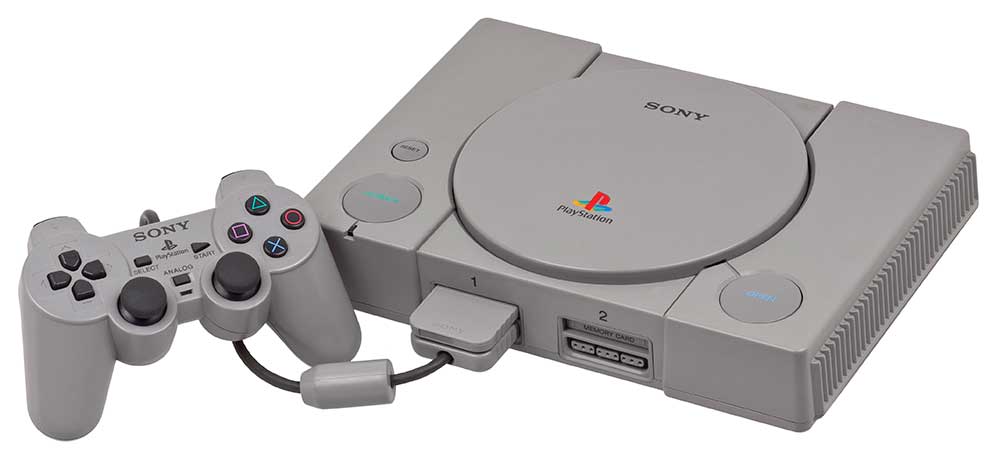
Sony PlayStation Console : Image via Wikimedia Commons
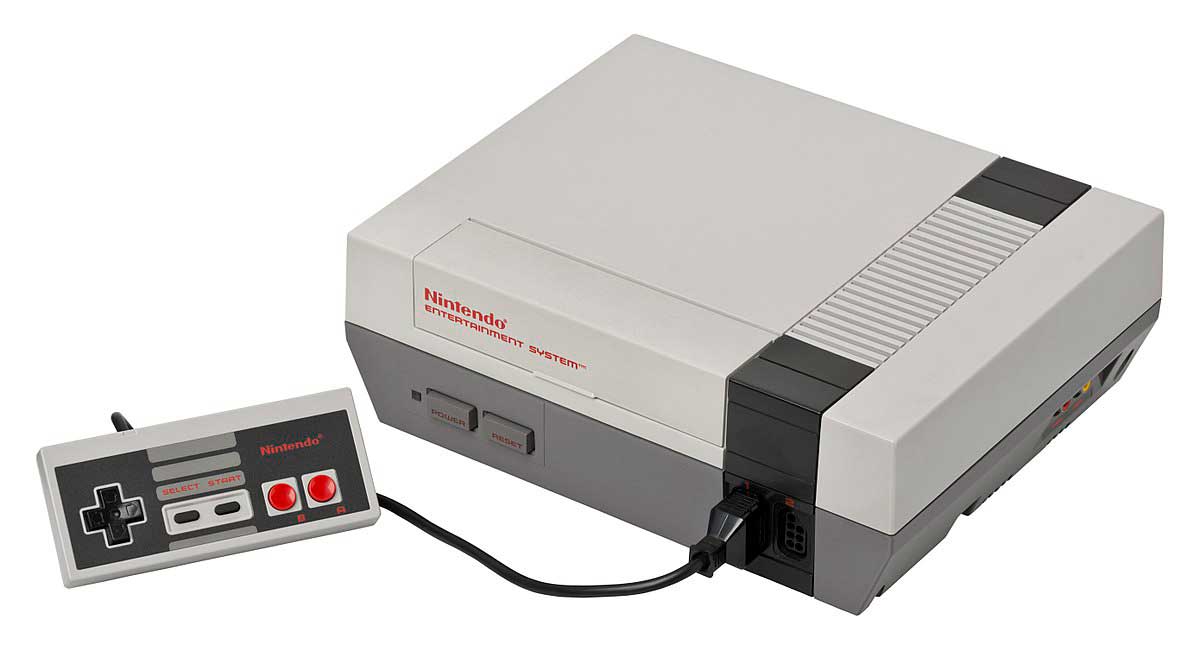
NES Console: Image via Wikimedia Commons
Rather than a brightly colored toy, the PlayStation was an entertainment center that would belong in any bachelor's living room.
Its CD player meant that the console wasn't limited to gaming. It also featured more mature titles, like Metal Gear Solid and Resident Evil.
The PlayStation proved that this approach to a gaming console would work. The PlayStation sold three times the units of the Nintendo 64. And its overall design has stayed the same for four generations.
By bringing in a new era of gaming consoles, Sony built a system whose core concept has survived for almost 25 years of updates.
Iconic Game of Generation Five: Final Fantasy VII (1997).
Final Fantasy VII marked the move of the landmark RPG series from Nintendo to PlayStation. The move, encouraged by the PlayStation's CD-based system, helped move Sony ahead of Nintendo.
Generation Six: The Console Wars Begin
For the past two decades, a console war has been burning like no other in history.
Here's what happened:
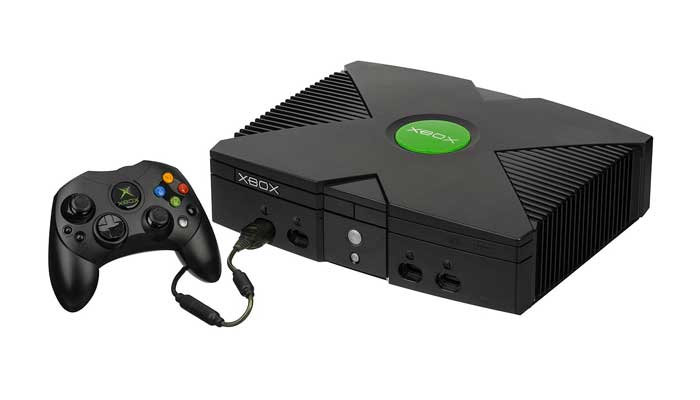
First released of Xbox by Microsoft: Image via Wikimedia Commons
The start of this war coincides with the introduction of Microsoft's Xbox console in 2001.
Of course, generation six actually began a year earlier. Sony released its PlayStation 2 and ran unopposed for that entire time.
In 2001, both the Nintendo GameCube and Microsoft Xbox were released. These three solidified the trio that has dominated gaming consoles ever since.

Sony Playstation 2: Image via Wikimedia Commons
Microsoft and Sony competed on relatively even terms -- they were both mostly-black multimedia consoles.
They contested each other based on the value of their exclusives and the power of their processors.
Nintendo, as usual, went their own way with the purple, more-childlike GameCube.
Its colorful controller and emphasis on games for everyone started to set Nintendo as a separate entity to the other two consoles.
But, unlike most other generations, there is still no clear winner.
All three manufacturers have jockeyed for the top spot for almost 20 years. Any consoles outside of the top three have either failed before they started, or burned out in obscurity.
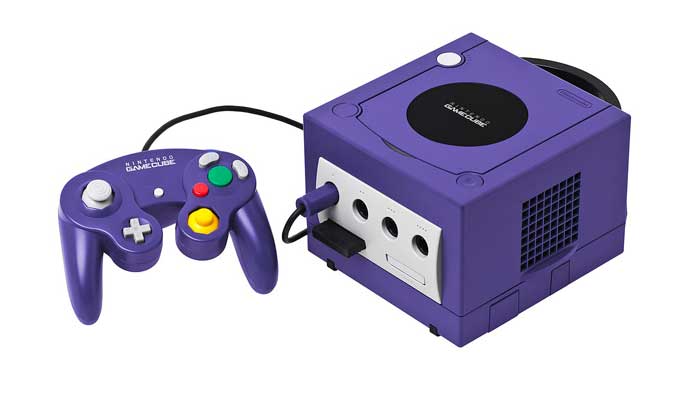
Nintendo Gamecube: Image via Wikimedia Commons
Microsoft Xbox
As much as the PlayStation and PlayStation 2 advanced gaming from the cartridge era, the introduction of the Xbox brought gaming consoles to their current state.
Here's how:
Microsoft built the Xbox to bring a gaming PC into the living room. It ran on twice the processing power of the PlayStation 2, and Microsoft advertised it for its online capabilities.
The console also had advanced storage, with an 8GB onboard hard drive. This eliminated the need for memory cards, which were an additional cost and could easily be lost.
This marketing proved a success, as the Xbox sold over one million copies in three weeks alone.
The Xbox made a name for itself in console exclusives:
The groundbreaking Halo series is responsible for making the console what it is.
Other exclusives like the Madden football franchise made it a must-have for men in their twenties -- a major market for the consoles.
While the Xbox's power was actually equal to the smaller GameCube, its overall design was the clear winner during the sixth generation.
A focus on a computer-like gaming experience and a design that appealed to older audiences gave newcomer Microsoft a leg up in the new console wars.
Iconic Game of Generation Six: Halo: Combat Evolved (2001).
Halo: Combat Evolved redefined what a first-person shooter could be. It gave players an engaging story and an open world to play in, driving demand for the Xbox and shaping the next three generations of gaming consoles.
Generation Seven: A Way For Everyone To Play
The seventh generation of gaming consoles deepened the three-way war between Nintendo, Sony, and Microsoft.
Graphics continued to advance, in some cases to near-photorealistic quality. The PlayStation 3 offered superior storage and fidelity with Blu-Ray capabilities.
But there's more:
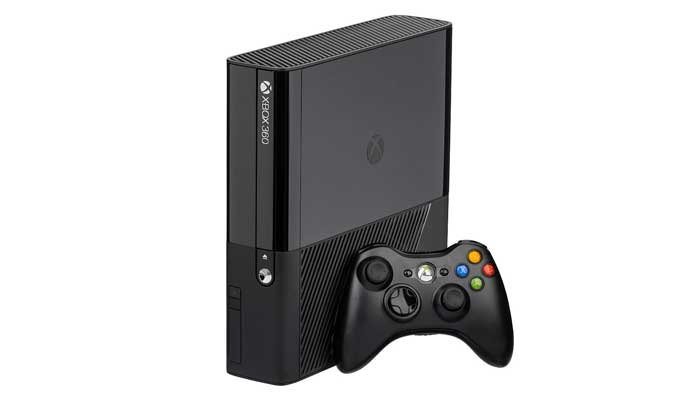
Xbox 360: Image via Wikimedia Commons
It was at this time, starting in 2005, that generations really started to stretch longer. The Xbox 360 was on shelves for eight years before its successor was released.
Part of this was due to the updateable nature of the consoles.
With every console connected to the internet, software updates became a regular occurrence. This greatly extended the life of gaming consoles.
Online gaming became a huge aspect of consoles. Game franchises which started as single-player or split-screen games began developing their online experience.
Also, physical games started their move towards obscurity. The PlayStation 3, the Xbox 360, and the Nintendo Wii all offered online marketplaces for digital games.

Sony Playstation 3: Image via Wikimedia Commons
Nintendo Wii
After two generations on the back foot, Nintendo came back swinging -- literally.
Here's how:
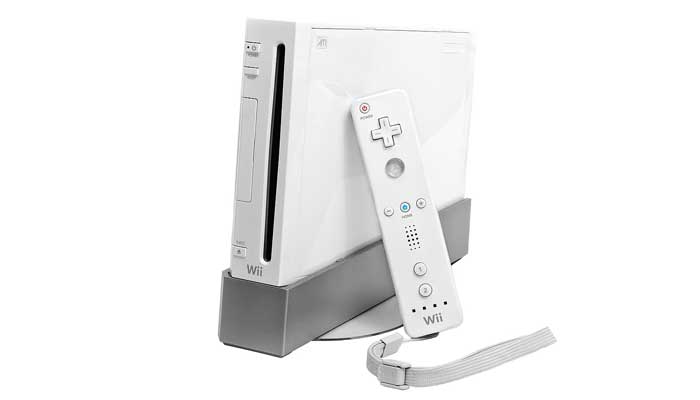
Nintendo Wii: Image via Wikimedia Commons
The Nintendo Wii set itself apart from its competition on day one. Rather than a bulky black box, the Wii was small, sleek, and white. Its controllers, slim rectangles, were the same way.
More importantly, the Wii introduced an all-new control method.
The remotes (or Wiimotes) worked with motion controls. You can point them at the included sensor bar, you can swing them like tennis rackets and baseball bats, and you can turn them like steering wheels.
All of a sudden, gaming wasn't just something for kids and college students.
The Wii was a phenomenon:
Its friendly controllers, with just a few intuitive buttons and motion controls, were accessible to people with arthritis or other conditions.
Kids were showing their grandparents how to play Wii, and their grandparents were having fun.
The Wii was even a way to get people in nursing homes up and active. Almost anyone could play the Wii, and nearly everyone wanted to.
Rather than focusing on graphics or processing speed, Nintendo's focus on fun and accessibility made them a clear winner in generation seven.
Iconic Game of Generation Seven: Wii Sports (2006).
Wii Sports was included in every Wii console sold, as a showcase of what the Wii could do. For many, its offerings of baseball. bowling, and tennis, among others, were more than enough for hours of enjoyment, and this simple game drove the console's popularity.
Failed Consoles: Casualties Of The Console Wars
The console wars have been a massive three-directional battle, but more than one other console has been caught in the crossfire.
While the first five generations of gaming consoles were full of failed competitors, the most recent three have quickly crushed any upstart who tried to get a foothold.
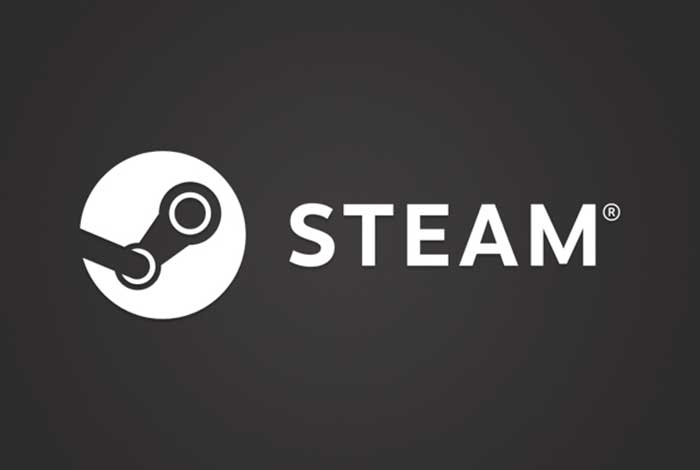
PC gaming giant Steam tried to get in on the console beat for five years, before giving up in early 2018.
Their Steam Machines were built with a similar ethos to the original Xbox. They wanted to bring PC-level gaming to the casual consumer.
But there were problems:
Their proprietary operating system, SteamOS, didn't support every game on Steam when the first Machines launched.
Between the console's price tag and its unclear audience, the Steam Machine failed to find purchase.
Open-source darling Android tried to carve out a niche as well with the Ouya.
This crowdfunded console was advertised as a more populist sort of gaming product. Its developers wanted the player to determine the sort of experience they wanted to have.
It even let anyone develop console games, without having to pay licensing fees.
An important side note -- this sort of freedom to publish helped contribute to the console crash of 1982.
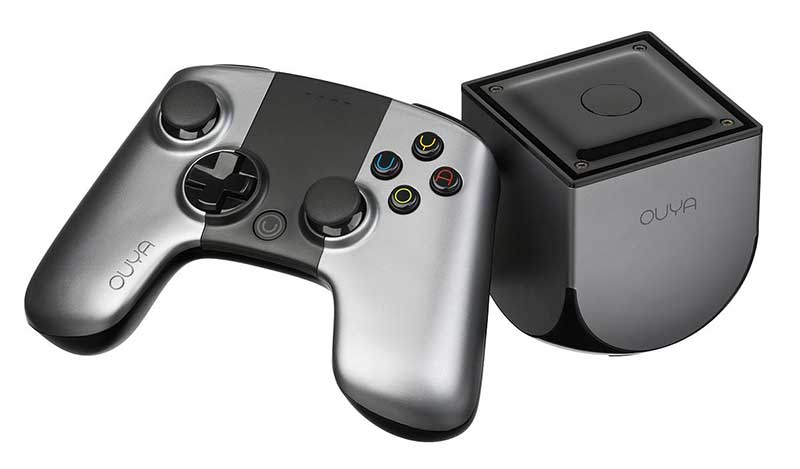
Ouya Gaming Console: Image via Wikimedia Commons
Even though the Ouya boasted the free-market sort of philosophy that drives the PC gaming world, it failed to hold any sway.
The Ouya ended up as another casualty among Sony, Microsoft, and Nintendo's ongoing contest.
The Future Of Video Game Consoles
As of now, the future of gaming consoles looks static.
But take a good look at where we are:
Microsoft, Sony, and Nintendo still dominate the market, and it seems as though the console wars are the foreseeable future.
Virtual reality has spread from a 1980s sci-fi dream, to a high-end peripheral, to nearly a household object.
Graphics processing has blurred the lines between what is real and what is rendered.
And the gaming world is always improving.
Generation Eight And Beyond
Where we stand now, generation eight has no end in sight.
The current consoles -- the Xbox One and the PlayStation 4 -- have been going strong since 2013, pushing the limit of what was once a console's lifespan.
The first hint of the next generation is the Nintendo Switch:
Nintendo's first generation eight console, the Wii U, suffered from a lack of marketing and an unclear separation from its predecessor.
Whether the Switch is an eighth or a ninth generation game console is the matter of debate.
But the Switch does take the advancements made by the Wii and Wii U and turn them into an even more unique game console.
With no release date in sight for the next PlayStation or Xbox, the future of consoles is unclear. Constant updates, with multiple editions of each console, make for longer generations.
Some speculate the prevalence of digital gaming spells the end of consoles altogether:
Game developer Ubisoft predicts that game streaming will eliminate the need for dedicated gaming consoles.
But just as someone playing the Magnavox Odyssey in 1972 could scarcely imagine a console like the PlayStation 4 existing, the next iteration of video games may be something completely different.
Featured Image: CC0 via Pixabay

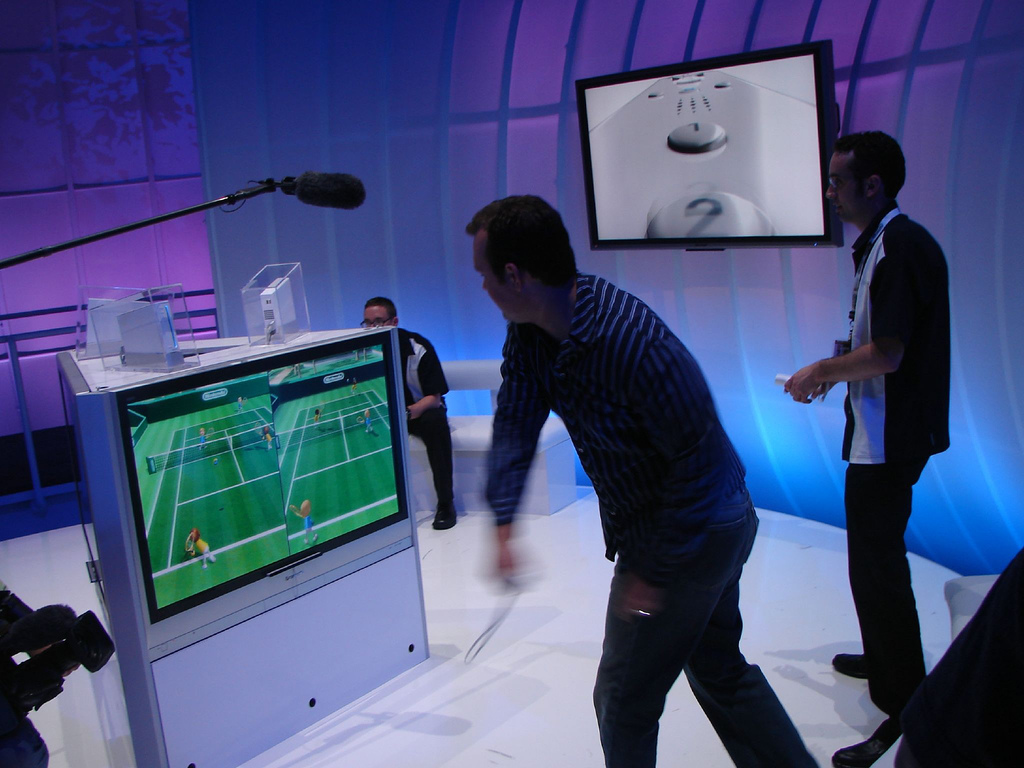
Leave a Reply